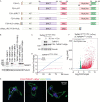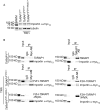Trypanosoma brucei RAP1 Has Essential Functional Domains That Are Required for Different Protein Interactions
- PMID: 32102938
- PMCID: PMC7045384
- DOI: 10.1128/mSphere.00027-20
Trypanosoma brucei RAP1 Has Essential Functional Domains That Are Required for Different Protein Interactions
Abstract
RAP1 is a telomere protein that is well conserved from protozoa to mammals. It plays important roles in chromosome end protection, telomere length control, and gene expression/silencing at both telomeric and nontelomeric loci. Interaction with different partners is an important mechanism by which RAP1 executes its different functions in yeast. The RAP1 ortholog in Trypanosoma brucei is essential for variant surface glycoprotein (VSG) monoallelic expression, an important aspect of antigenic variation, where T. brucei regularly switches its major surface antigen, VSG, to evade the host immune response. Like other RAP1 orthologs, T. brucei RAP1 (TbRAP1) has conserved functional domains, including
Keywords: RAP1; Trypanosoma brucei; protein-protein interaction; telomere.
Copyright © 2020 Afrin et al.
Figures







Similar articles
-
TbRAP1 has an unusual duplex DNA binding activity required for its telomere localization and VSG silencing.Sci Adv. 2020 Sep 18;6(38):eabc4065. doi: 10.1126/sciadv.abc4065. Print 2020 Sep. Sci Adv. 2020. PMID: 32948591 Free PMC article.
-
Suppression of subtelomeric VSG switching by Trypanosoma brucei TRF requires its TTAGGG repeat-binding activity.Nucleic Acids Res. 2014 Nov 10;42(20):12899-911. doi: 10.1093/nar/gku942. Epub 2014 Oct 13. Nucleic Acids Res. 2014. PMID: 25313155 Free PMC article.
-
Trypanosoma brucei RAP1 maintains telomere and subtelomere integrity by suppressing TERRA and telomeric RNA:DNA hybrids.Nucleic Acids Res. 2017 Jun 2;45(10):5785-5796. doi: 10.1093/nar/gkx184. Nucleic Acids Res. 2017. PMID: 28334836 Free PMC article.
-
Regulation of Antigenic Variation by Trypanosoma brucei Telomere Proteins Depends on Their Unique DNA Binding Activities.Pathogens. 2021 Jul 30;10(8):967. doi: 10.3390/pathogens10080967. Pathogens. 2021. PMID: 34451431 Free PMC article. Review.
-
Unwrap RAP1's Mystery at Kinetoplastid Telomeres.Biomolecules. 2024 Jan 4;14(1):67. doi: 10.3390/biom14010067. Biomolecules. 2024. PMID: 38254667 Free PMC article. Review.
Cited by
-
BRCT Domains: Structure, Functions, and Implications in Disease-New Therapeutic Targets for Innovative Drug Discovery against Infections.Pharmaceutics. 2023 Jun 27;15(7):1839. doi: 10.3390/pharmaceutics15071839. Pharmaceutics. 2023. PMID: 37514027 Free PMC article. Review.
-
In vivo architecture of the telomerase RNA catalytic core in Trypanosoma brucei.Nucleic Acids Res. 2021 Dec 2;49(21):12445-12466. doi: 10.1093/nar/gkab1042. Nucleic Acids Res. 2021. PMID: 34850114 Free PMC article.
-
TbTRF suppresses the TERRA level and regulates the cell cycle-dependent TERRA foci number with a TERRA binding activity in its C-terminal Myb domain.Nucleic Acids Res. 2021 Jun 4;49(10):5637-5653. doi: 10.1093/nar/gkab401. Nucleic Acids Res. 2021. PMID: 34048580 Free PMC article.
-
TbRAP1 has an unusual duplex DNA binding activity required for its telomere localization and VSG silencing.Sci Adv. 2020 Sep 18;6(38):eabc4065. doi: 10.1126/sciadv.abc4065. Print 2020 Sep. Sci Adv. 2020. PMID: 32948591 Free PMC article.
-
POLIE suppresses telomerase-mediated telomere G-strand extension and helps ensure proper telomere C-strand synthesis in trypanosomes.Nucleic Acids Res. 2022 Feb 28;50(4):2036-2050. doi: 10.1093/nar/gkac023. Nucleic Acids Res. 2022. PMID: 35061898 Free PMC article.
References
Publication types
MeSH terms
Substances
Grants and funding
LinkOut - more resources
Full Text Sources
Molecular Biology Databases
Miscellaneous
